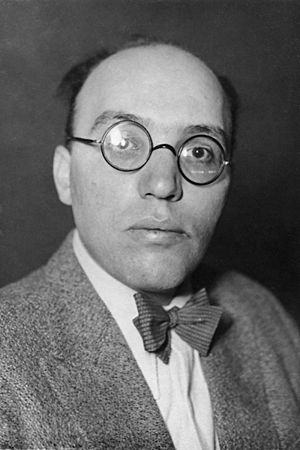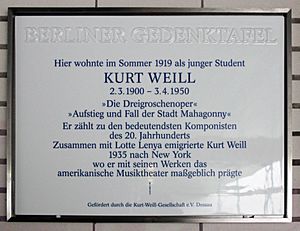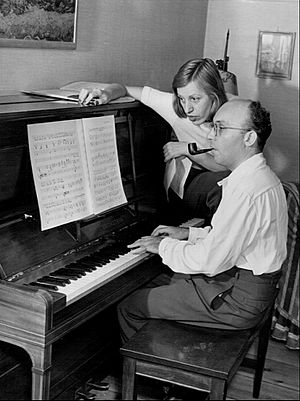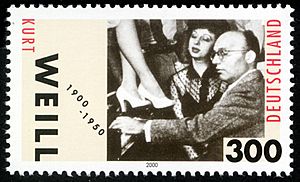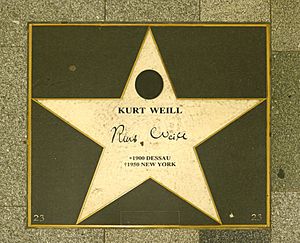Kurt Weill facts for kids
Kurt Julian Weill (born March 2, 1900 – died April 3, 1950) was a famous composer. He was born in Germany but later became an American citizen. Weill was best known for writing music for plays and musicals.
He worked closely with a writer named Bertolt Brecht. Together, they created many popular shows. Their most famous work was The Threepenny Opera. This show included the well-known song "Mack the Knife". Kurt Weill believed in writing music that could help society. He also composed music for concerts and pieces about Jewish culture. He became a citizen of the United States in 1943.
Contents
Early Life and Music
Kurt Weill was born on March 2, 1900. He was the third of four children. His family was Jewish and lived in Dessau, Germany. His father was a cantor, a singer who leads prayers in a synagogue.
When he was 12, Kurt started piano lessons. He also began writing his own music. His first known song, "Mi Addir: Jewish Wedding Song," was written in 1913.
In 1915, Kurt took private lessons with Albert Bing. Bing was a music director at the local theater. He taught Kurt piano, how to compose, music theory, and how to conduct. Kurt first performed in public as a pianist in 1915. He played both alone and with singers. In the next few years, he wrote many songs. These songs used words from famous poets.
Weill finished high school in 1918. At 18, he joined the Berlin University of the Arts. There, he studied composition with Engelbert Humperdinck. He also learned conducting and music theory. In the same year, he wrote his first string quartet.
Developing His Musical Style
After World War I, Kurt's family faced money problems. In 1919, he left his studies. He went back to Dessau to work at a theater. He helped musicians practice their parts. During this time, he wrote an orchestral suite. He also composed a song cycle called Schilflieder ("Reed Songs").
Later, he became a music director in Lüdenscheid. He directed operas and operettas for five months. He then composed a cello sonata. He also wrote a one-act opera called Ninon de Lenclos, which is now lost.
Studying with Busoni
In 1920, Kurt Weill met Ferruccio Busoni. Busoni was a famous composer and teacher. He accepted Kurt as one of his top students in Berlin.
From 1921 to 1923, Kurt studied with Busoni. He also learned from Philipp Jarnach. During this time, he wrote his first symphony. Busoni greatly influenced Kurt's music. At first, Kurt's music was very emotional. But Busoni helped him move towards a style where music could comment on the story. This was similar to the "distancing effect" used by his future partner, Bertolt Brecht.
To help his family, Kurt also played piano in a tavern. In 1922, he joined a group of artists called the November Group. That year, he wrote a psalm and a divertimento for orchestra. His children's play Die Zaubernacht (The Magic Night) was performed. This was his first musical theater work shown to the public.
Kurt also taught music to private students from 1923 to 1925. Some of his students became famous musicians themselves. In his last year of studies, Kurt wrote more pieces. These included Quodlibet and Frauentanz. His Divertimento for Orchestra was performed by the Berlin Philharmonic. In December 1923, he finished his studies with Busoni.
Success in the 1920s
In 1924, Kurt Weill met the playwright Georg Kaiser. They worked together on several short operas. That summer, he also met the singer and actress Lotte Lenya. They married in 1926. Lotte was a great supporter of Kurt's work. After he died, she worked hard to make sure his music was remembered. She even started the Kurt Weill Foundation.
Kurt also wrote many reviews for a radio guide. This helped him stay connected to the music world.
Weill became very popular in Germany in the late 1920s. His musical theater works and songs were a big hit. Other composers admired his music.
Working with Bertolt Brecht
His most famous work is The Threepenny Opera (1928). This was a new version of an older play called The Beggar's Opera. Kurt wrote it with Bertolt Brecht. The show included Kurt's most famous song, "Mack the Knife". The Threepenny Opera was a satire. It made fun of society and commented on social issues. For Weill, it was a way to make opera more modern and exciting.
The show was so successful that it was made into a film in 1931. Weill and Brecht even tried to stop the film through a lawsuit. Weill won his part of the case.
Kurt continued to work with Brecht on other musicals. These included Happy End (1929), known for songs like "Surabaya Johnny." They also created the children's opera Der Jasager (1930) and the opera Rise and Fall of the City of Mahagonny (1930). This opera featured the song "Alabama Song," which was later recorded by many artists.
However, Kurt and Brecht stopped working together in 1930. They had different ideas about politics. Weill felt Brecht wanted to make their work too political. Weill's wife, Lotte Lenya, said he felt he couldn't "set the Communist Manifesto to music."
Life in America
Kurt Weill left Germany in March 1933. The Nazis were gaining power. As a Jewish composer with certain political views, he was a target. The Nazis tried to stop his plays from being performed. He first went to Paris, France. There, he worked with Brecht again on a ballet called The Seven Deadly Sins.
In 1935, he moved to the United States. He and Lotte Lenya settled in New York City. He wanted to learn about American music. He studied popular songs and stage music. His American works became very respected. They also helped shape American musical theater.
Kurt worked with famous American writers. He wrote music for a film by Fritz Lang. Weill wanted to create a new kind of American opera. It would be both popular and artistic. A great example is Street Scene. This opera was based on a play by Elmer Rice. The lyrics were by Langston Hughes. For Street Scene, Weill won the first ever Tony Award for Best Original Score.
In the 1940s, Weill lived upstate New York. He often traveled to New York City and Hollywood for his work. He was very active in supporting America's entry into World War II. After the US joined the war, he created many projects to help the war effort. He even worked as an air raid warden near his home. He became an American citizen in 1943.
Weill believed music should be useful to society. In the US, he wrote Down in the Valley. This opera included American folk songs. He also wrote songs to support the war. These included "Schickelgruber" and "Buddy on the Nightshift." He even wrote a song with Brecht again, "Ballad of the Nazi Soldier's Wife." This song described the gifts a soldier's wife received from the war front. It ended with her receiving a widow's veil from Russia.
Besides "Mack the Knife" and "Pirate Jenny," some of his most famous songs are "Alabama Song," "Surabaya Johnny," "Speak Low," "Lost in the Stars," "My Ship," and "September Song."
Death
Kurt Weill had a heart attack shortly after his 50th birthday. He died on April 3, 1950, in New York City. He was buried in Mount Repose Cemetery in Haverstraw, New York. The words on his gravestone are from his song "A Bird of Passage":
This is the life of men on earth:
Out of darkness we come at birth
Into a lamplit room, and then –
Go forward into dark again.
(lyric: Maxwell Anderson)
A friend, Maxwell Anderson, spoke at his funeral. He said Kurt made "thousands of beautiful things" during his short and troubled life.
Weill's Influence
Kurt Weill's music is still performed today. It is played in both popular and classical styles. During his life, his wife, Lotte Lenya, was the main singer of his works. After he died, "Mack the Knife" became a jazz standard. Many famous artists have recorded his music. These include Nina Simone, Frank Sinatra, The Doors, David Bowie, and PJ Harvey.
In 1985, a tribute album called Lost in the Stars: The Music of Kurt Weill was released. It featured artists like Tom Waits and Sting singing Weill's songs. Another album, The Young Gods Play Kurt Weill, was released in 1991. Kurt Weill is a member of the American Theater Hall of Fame.
Kurt Weill Centre
The Kurt Weill Centre in Dessau, Germany, opened in 1993. It has a museum, library, and archive. It also organizes an annual festival celebrating Weill's music. The center is in a house designed by the famous architect Walter Gropius. This house is part of a World Heritage Site. The center is important for preserving Weill's legacy.
Kurt Weill Foundation for Music
The Kurt Weill Foundation was started by Lotte Lenya in 1962. It is a non-profit group. Its goal is to help people understand Kurt Weill's life and music. It also works to keep the legacies of both Kurt and Lotte alive. The foundation runs a competition for singers. It also offers grants and fellowships. It publishes a newsletter and research on Weill's work.
See also
 In Spanish: Kurt Weill para niños
In Spanish: Kurt Weill para niños
- A Kurt Weill Cabaret (Broadway 1979)
- Berlin to Broadway with Kurt Weill (off-Broadway 1971)
- LoveMusik (Broadway 2007)


